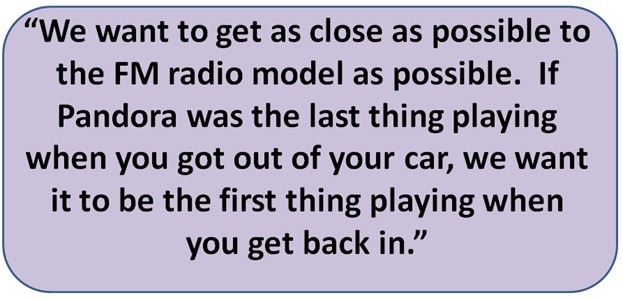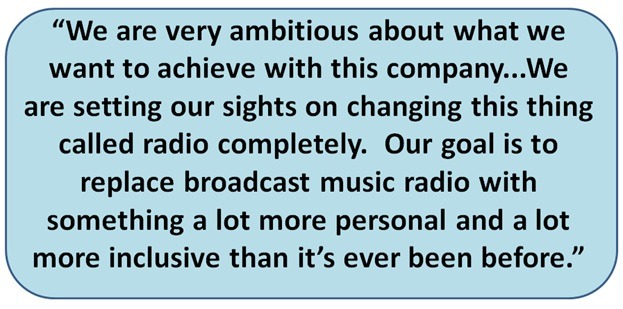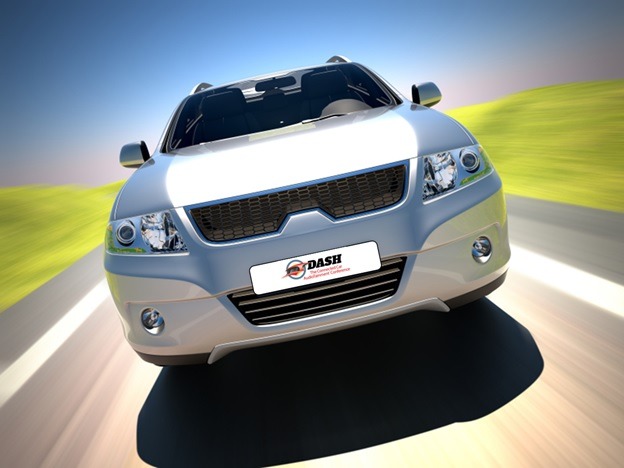Today’s post title is the only possible conclusion I can reach about broadcast radio’s lack of strategic focus and apparent concern about what is happening with its present and future in “connected cars.”
This became even clearer to me after DASH last week. It was gratifying to see a large, enthusiastic crowd eager to learn, exchange, and grow. But the lack of C-suite attendance underscored that for radio, the “connected car” issue continues to fly under the radar as a pressing issue, as absurd as that sounds.
Say what you will about HD Radio, iBiquity, and Bob Struble, but if it weren’t for them, broadcast radio would be all but invisible in the minds of OEMs and Tier 1s who are manufacturing the hardware and software that will go a long way toward determining radio’s future access and usage.
To the automakers, their vision of “radio” is often SiriusXM, Pandora, and other enthusiastic players vying for real estate in the “center stack.” These brands have presence. They show up at automotive conferences and CES. Save for iHeart Radio and NPR, it’s a challenge to think of other broadcast entities that are focused on solutions and partnerships with the automotive industry. There are apparently more pressing matters.
All this came to a head last week when Pandora’s VP of Automotive Business Development, Geoff Snyder, gave this quote to Gigaom:
That sounds like a challenge to me, and one that broadcast radio ought to take seriously. But it’s certainly not anything new. In fact, Pandora has engaged in saber-rattling for a long time now, making their goals and aspirations very transparent. From day one, Tim Westergen’s aim has been to usurp and ultimately replace broadcast radio in the hearts and minds of consumers.
In fact, five years ago this week, Tim Davis and I were invited to a Pandora Meet-Up here in Detroit. As Westergren addressed several hundred fans in a packed suburban movie theater, we taped him making this assertion about Pandora’s ultimate game plan:
Email recipients click here to watch the Westergren video
Here’s the money quote:
We wrote a blog about it as well, with a clear warning about the need to mobilize (literally and figuratively) for the battle ahead.
That battle has now moved to the “connected car.” According to Gigaom, Pandora has now partnered with 26 different auto brands, featuring 145 vehicle models, to ensure its presence in car dashboards. This is an arduous, expensive process because there is virtually no standardization across the different OEMs and even some of their own brands. For example, Ford has My Ford Touch and SYNC AppLink – two different platforms for their line of vehicles.
For Pandora, this process has been expensive, cumbersome, complicated, and frustrating. But this investment in time and resources has paid off, based on the number of car commercials you see on TV that feature that now-famous P logo in these hot new “center stacks.” Pandora isn’t paying for that valuable product placement – car manufacturers understand the growing popularity of this pure-play music service and how it can attract consumers to showrooms.
In the meantime, with few exceptions, broadcast radio has done virtually nothing during this same time frame to develop an automotive strategy. While radio clearly needs a partnership plan with OEMs or even car dealers, the industry is content to fight other battles, often oblivious to the paramount importance of maintaining presence in its #1 listening location and #1 sales revenue category.
All the while, broadcast radio has centered its efforts on ignoring, discrediting, or writing off the Pandora threat. It’s not radio, it shouldn’t be measured alongside terrestrial products, its numbers are inflated, and it will never be profitable.
Just so you know, Pandora’s Geoff Snyder was a featured panelist at DASH, along with other content creators in the Internet streaming space. We appreciate the fact that he was there. Geoff is a smart executive, willing to tell his company’s story so that our attendees could learn something about their aspirations and activities. If broadcast radio is going to address these challenges, it cannot ignore the competitive realities now being posed by a myriad of media options in “connected cars.”
As Gartner’s Thilo Kowslowski intoned at Convergence a couple years ago, “There’s a hole in the fence,” allowing for more broadcast radio challengers to find their way into dashboards.
Pandora has long recognized that opportunity and is building infrastructure that will achieve scale as the “connected car” movement grows. Right now, these vehicles are more popular among Boomers than Millennials, mostly for economic reasons. But given the push that every OEM is making in this space, every vehicle rolling off the assembly line will be “connected” in just a few short years.
We are gratified with our efforts to grow awareness about this space, culminating in two highly successful DASH Conferences. The “connected car” is finally on the broadcast radio’s radar screen.
It’s not enough. The powers that be in radio, along with every industry trade organization from the RAB to the NAB to PRPD to Greater Public, need to recognize the threat – and the opportunity – that is the “connected car.”
That would make me happier than seeing a full house at DASH.
The fault is not in our cars, but in ourselves.
- What To Do If Your Radio Station Goes Through A Midlife Crisis - April 25, 2025
- A 2020 Lesson?It Could All Be Gone In A Flash - April 24, 2025
- How AI Can Give Radio Personalities More…PERSONALITY - April 23, 2025







Speaking only for myself: Radio urgently needs to decide if its going to be every man (or broadcaster) for him/herself in the battle for the dash or is it time to be united and find (and fund) the leadership to ensure its future? I prefer the latter.
I believe the auto industry is willing to listen. That was clear at DASH.
Much applause to the efforts of Bob Struble and iBiquity for its efforts to keep broadcast radio in the eyes and ears of the OEMs. But beyond Bob, who is truly representing the broadcast industry in Detroit?
You’ve hit on some great observations, Dan, as well as some key questions. We’re an industry that features diverse ownership and groups that have very different priorities – from commercial to public to networks to formats. And yet, the need to speak in one voice right here in Detroit – where it matters – is indeed a key. Thanks for coming to DASH.
Radio needs to do a lot with respect to the center stack, but the biggest thing it needs to do is make its product more robust and competitive. Pandora has done the hard and dirty work of negotiating one painstaking deal after another – and radio doesn’t seem to have much stomach for painstaking.
Radio’s real vulnerability comes from the Internet, yet radio has virtually no internet strategy – IMO, iHeartradio is the embodiment of a non strategy with user numbers (that reflect roughly 75% of what radio is doing online) roughly 1/7 of Pandora’s to prove it.
I’n not sure what radio would add to the center stack right now, but it needs to develop something and fast. Painstaking work needs to be done negotiating with the music industry so that streaming music can be profitable – and that’s just the start. And then rinse/repeat with the auto industry. Detroit and the pure plays are investing real time and talent into product development and alliances. Radio…well I don’t think they can fix this with more Christmas season firings. But you can bet they are already in the works.
“Painstaking” is the keyword, Bob. The difference is in playing the long game. Companies that are able to think and strategize beyond Q4 have a strong chance of surviving in this amped up race Thanks for taking the time to comment, and I’m hoping you’re mistaken about the holiday axings.
Duplicating Tim Westergren’s “meet & greet” is a hurdle for the radio industry. Can you recall a radio CEO sitting down with a local audience in the manner Tim did at hundreds of colleges across our nation?
To be discussing radio’s position on the dashboard at this late date is akin to a squirrel waiting until the first snowfall to gather its nuts. Yet, this is not the biggest problem; it’s the industry’s inability to follow through with difficult tasks, like meeting local audiences and moving itself to digital.
Consider: This is only a partial list of initiatives we’ve witness radio launch to meet new online competition. Staying competitive requires more than just talking about what “you’re going to do.” Too often, that as far as it gets in radio.
LMiV
Network Radio Compliance Council
Radio Communicators Group
Radio 2020
Radio Heard Here
The HD Radio Alliance
Radio. You Hear It Here First
Less is More
Radio Creative Resource Group
Format Lab
TotalRadius
HD Radio University
WhyRadio?
Blink Ads
The International Broadcasters IdeaBank
freeradioonmyphone.org
It is so much more exhilarating being on the offensive and doing the “climb.” Westergren did it well, interfacing with enthusiastic fans, and not taking anything for granted. The radio industry became so used to resting on its laurels, always assuming that the audience would always be there. I think your point about not completing projects (and that’s a LONG list) says a lot about an industry that rarely, if ever, speaks in one voice. There have been a lot of initiatives, but it’s unusual to see the industry truly get behind one. I’m sure that’s what Jeff Smulyan is thinking as NextRadio rolls out.
NextRadio probably isn’t the best test case for broad based industry support because in a best case scenario it won’t have much impact on ratings or revenue (“…see, we all got behind it and nothing much happened”). Big changes in streaming royalties could have a huge impact on radio and might be a better test case.
NextRadio is reaching for the stars by standing on a table IMO.
Whatever you think about NextRadio, its acceptance during this past year – punctuated by a strong Radio Show push – does show that at least in general, the industry supports it. To the degree to which they truly get behind it with on-air promos and DJ endorsements remains to be seen. Thanks, Bob.